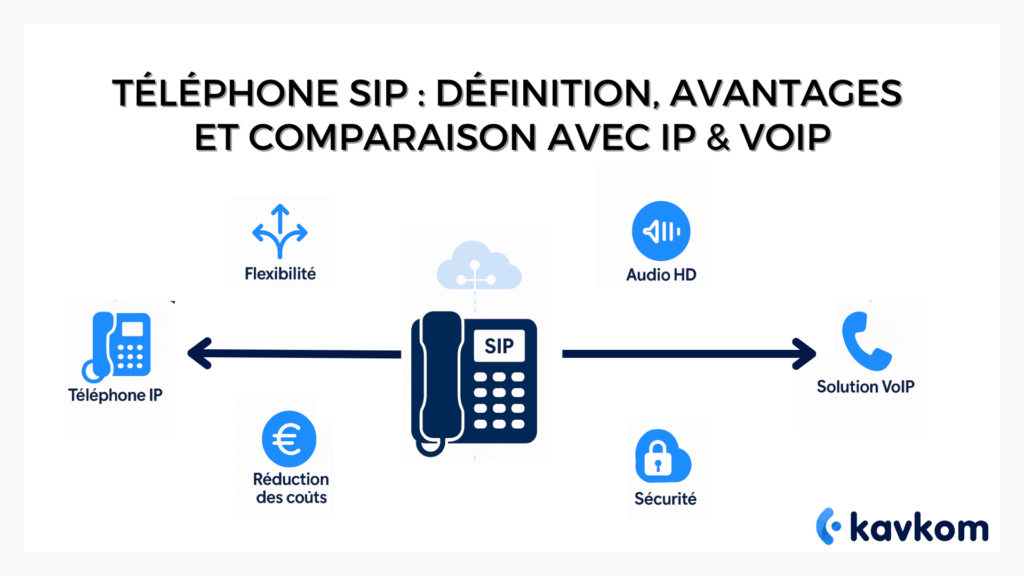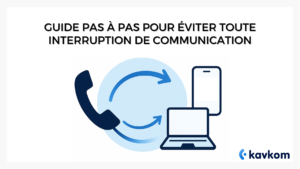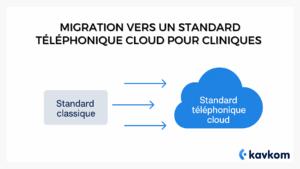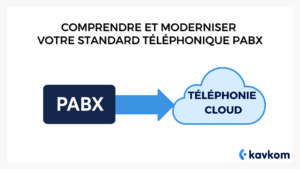If you’re looking to clarify the distinctions between SIP phones, IP telephony and VoIP, this article is for you. You’ll discover how a flexible, no-commitment, pro-rated cloud solution can transform your calls and improve call center performance. We give you the keys to integrating SIP with confidence.
Points to remember
- A SIP phone uses the SIP protocol to establish and manage calls over the Internet.
- The difference between VoIP, IP telephony and SIP phones lies in their role: principle, system and terminal.
- The key benefits: flexibility, lower costs, better audio quality.
- Cloud integration makes implementation fast, secure and scalable.
- SIP phones are equally suited to call centers, sales teams and SMEs with multiple sites.
What is a SIP phone?
Imagine an old-fashioned telephone operator. He takes the call, finds the right person, connects, puts the call on hold if necessary, then hangs up when it’s over. SIP(Session Initiation Protocol ) plays this role in the digital world. It’s an Internet protocol that organizes communication sessions on the Internet. It tells you who’s calling whom, when to ring, how to transfer and when to end. It doesn’t transport voice, it orchestrates communication.
So what is a SIP phone? It’s a telephone that knows how to speak this language. In concrete terms, a SIP phone can be an IP phone on a desk, a wireless handset, or a softphone on a computer or mobile. It registers with a server, then you can make and receive calls via the SIP protocol, with your usual numbers, both in the office and remotely. Voice over IP(VoIP) then takes over the transmission of voice over IP.
VoIP, IP telephony and SIP phones: what are the differences?
VoIP refers to the general idea of voice over the Internet. IP telephony is the enterprise solution that drives everything: the telephone system with numbers, queues, messaging and integrations. SIP phones are the terminals and applications that use SIP to establish the relationship, then speak in audio. Three layers that complement each other to offer a simple experience, ready for multimedia and the cloud.
Why is it useful? Because this open standard makes your equipment interoperable and your park easy to upgrade. You can add stations, connect sites, activate teleworking users, without rewiring the building. In short, SIP transforms an IP network into a professional telephone service that’s easy to understand and control.
Express glossary
- SIP(Session Initiation Protocol) protocol that initiates, manages and terminates a call session over the Internet.
- VoIP(voice over IP) voice travels in packets over the Internet.
- IP telephony enterprise solution that manages numbers, routing, messaging and integrations.
- SIP telephone physical extension or softphone that uses SIP to establish the call.
- IP phone network-compatible office phone and IP services.
- IP(Internet Protocol) technical basis for routing data packets.
Advantages of SIP phones
The timetable is accelerating. ARCEP has approved the gradual closure of the copper network and the end of PSTN openings, with a switchover organized in batches until 2030. Clearly, staying with analog is no longer a sustainable plan: we need to move to Internet telephony and control communications in the cloud.
Flexibility and Cost Reduction
With IP telephonyyou replace rigid telephone lines with an adaptable telephony service. Adding workstations for telecommuting, opening a new site, absorbing a peak in activity: it’s all done via the Internet, without rewiring the telephone network.
On the budget side, packet networks (VoIP) can cost significantly less than fixed telephony over the switched telephone network; the order of magnitude often quoted is up to half that of the switched circuit, depending on the implementation context.
In this context, Kavkom offers a concrete solution: rapid activation of SIP phones and softphones, no imposed hardware, subscriptions tailored to the needs of call centers and SMEs alike, and prorated billing so that you only pay for actual usage. The result: you can make and receive calls over the Internet with pro features (routing, IVR, recording) without tying up capital in equipment.
Audio Quality and Performance
Audio quality has entered a new era. Broadband Voice-over-IP (VoIP) has significantly improved intelligibility, especially in contact centers: less effort to listen, faster exchanges.
With a good Internet connection, a little QoS on the internal telephone network, and well-tuned DECT desk phones or cordless phones, you get a stable, measurable voice experience. With Kavkom, you can connect your own IP phones or softphones, without any hardware requirements. The solution works entirely in the cloud, whatever equipment you choose.
Comparison between SIP phones, IP telephony and VoIP
The jungle of acronyms is frightening at first glance. SIP phone, IP telephony, VoIP… everything seems interchangeable. Yet each term has its own precise role. Understanding these differences will help you avoid buying a Ferrari when a scooter will do, or vice versa.
Technical differences
- VoIP (Voice over IP)
It’s the whole concept: transmitting voice over theInternet Protocol rather than the traditional telephone network. Think of it as a promise: yes, voice can travel over the Internet. - IP telephony
This is the complete business solution. A IPBX (orchestrates communications, manages numbers, routing, messaging, queues and switchboard. It’s the toolbox that brings VoIP to life on a daily basis. - SIP phone
Finally, the real thing. The SIP phone is the terminal – desk phone, IP phone, wireless handset, softphone– that speaks SIP(Session Initiation Protocol ). This Internet protocol establishes and terminates communication sessions. It makes calls possible, transferable and controllable.
Quick reference chart
| Element | Main role | Example of concrete use |
|---|---|---|
| VoIP | Voice over IP transport | Making an audio call over the Internet |
| IP telephony | Complete telephony system (IPBX, switchboard, etc.) | Call center, multi-site company |
| SIP phone | Terminal that speaks SIP to establish the call | IP desktop phone, softphone application |
Here, Kavkom ‘s strength lies in including all the essential features (IVR, recording, supervision) with no hidden costs, while letting you use your existing IP phones. No extra hardware costs, no lock-in.
Use cases and concrete benefits
- For sales teams:
A softphone installed in 5 minutes enables calls to be made from the CRM, even when working from home. Contacts are displayed, records are retrieved, and the agent remains effective from any location. - For call centers:
TheIPBX distributes calls, records conversations and supervises queues. VoIP or DECT telephones connect directly to the Internet, without heavy rewiring. - For multi-site SMEs:
A single IP telephony service connects several offices. Employees can use the company phone line from a mobile app. In the meeting room, a single SIP station can be used to launch group calls, with the same quality as at head office.
In short, these three concepts fit together like Russian dolls: VoIP is the principle, IP telephony is the system, and the SIP phone is the concrete tool. Properly aligned, they offer modern, seamless telephone communication that is, above all, accessible to organizations of all sizes.
Integrating SIP phones into a cloud infrastructure
Switching to IP telephony isn’t heavy surgery. It’s more like plugging a new tool into your digital box: fast, flexible and designed for everyday use. Integrating a SIP phone into a cloud environment follows the same logic. No complex hardware to install, no time-consuming interventions: just a few SIP account settings and your telephony system is ready to host your teams on the Internet.
With a solution like Kavkom, commissioning is immediate. No need for hardwareIPBXs or cabling: you activate your terminals (desk phones, softphones, wireless handsets), assign accounts and start making and receiving calls. The cloud telephony service model allows you to start small and expand without blocking, perfectly suited to the needs of a growing SME or contact center.
Key steps and best practices
There are three simple steps to successful integration:
- Configure your SIP accounts with the cloud-hosted switchboard.
- Checkbroadband Internet quality and, if possible, prioritize voice traffic on the internal Internet network.
- Define basic rules: voicemail, transfers, even activate an interactive menu for incoming calls.
A virtual PBX(software IPBX) takes over: it applies your rules, manages simultaneous calls, and connects your office or videoconference teams. Some solutions, such as Kavkom, offer zero-touch provisioning: your extensions are installed without any user-specific configuration.
Technical Support and Security
Quick installation, yes. But always secure. Voice flows need to be encrypted, and access needs to be tightly controlled. A modern cloud platform includes encryption, RGPD compliance and advanced telecom options.Technical support then becomes essential: when in doubt, you’re not alone with your cables, but accompanied by experts.
Deployment checklist
- Are your lines and accounts created and tested?
- Is your Internet connection stable enough to support VoIP?
- Are your rules (messaging, transfers, queues) configured in the interface?
- Do you know who to call on the support side in the event of a problem?
Practical examples of SIP phone use
A SIPi phonecan be used in dozens of different contexts: in the office, on the move, or even telecommuting with a simple softphone. The advantage is that the same account follows you everywhere: in the office with an IP phone, at home with an app, or in a meeting with a laptop. SIP lets your teams make calls and stay in touch, regardless of location.
Call Center Use Cases
In a contact center, theIPBX becomes the orchestra conductor. The
With IP telephony, you’re no longer limited by the internal telephone network of a single site. Teams from several sites, or even telecommuters, can work on the same platform, and managers control everything from a cloud interface. That’s the advantage of a truly modern telephony service: centralization without complexity.
Professional feedback
One sales manager sums it up this way: “Our agents use VoIP phones in the office, softphones on the move. Regardless of the device, the call goes through. Telephony via IP no longer imposes borders.
For others, the value lies elsewhere: in flexibility. You can open new lines at the click of a button, connect a secondary site without any work, or provide secure access for a freelancer. All this is possible because communications pass through the cloud, with the same voice transmission as a conventional telephone.
Three typical situations where SIP changes the game
- Teleworking: an agent activates his SIP account on a softphone and continues to process his files without interruption.
- Meeting room: a single SIP station enables calls to be made from the company network, with HD quality.
- Nomadic team: sales reps use their cell phones as SIP phones and remain reachable on their business number.
In short, SIP phones are not a gadget. They are the concrete link in the chain of IP telephony: the visible part of a telephony system that simplifies everyday life, while opening the way to more flexible and productive uses.
FAQ – Frequently asked questions
What is a SIP phone and how does it work?
A SIP phone is a telephone (physical or softphone) that speaks SIP(Session Initiation Protocol ). This Internet protocol establishes, manages and terminates communication sessions. Voice is then transferred to Voice over IP, i.e. voice transmission via the IP protocol . Your communications work just like a conventional telephone, but they travel over the Internet.
What are the advantages of SIP phones in terms of flexibility and cost reduction?
With IP telephony, you can add or remove extensions at the click of a button, equip telecommuters and avoid the fixed costs of traditional phone lines. With a SIP trunk, you consolidate your call flows and reduce your costs compared with the dial-up telephone network. In short, you pay only for what you use, and everything goes via the Internet.
How do SIP phones compare with IP telephony and VoIP?
The SIP phone is the terminal (extension or application) used to make and receive calls.
What are the key steps to effectively integrating a SIP phone into a cloud infrastructure?
All you have to do is create your SIP accounts, connect your extensions to an IPBX or a cloud-based PBX, and check the stability of your Internet connection. Most modern solutions offer virtually automatic provisioning. The idea is to transform an existing Internet network into a complete switchboard, ready to handle your calls.
Conclusion
SIP telephony has become the cornerstone of modern communication: no need for cumbersome hardware, your SIP phones and softphones are all you need to handle everyday calls. Thanks to Voice over IP, businesses benefit from clear audio quality, unprecedented flexibility and lower costs.
With cloud solutions like Kavkom, everything becomes simpler: no hardware investment, immediate commissioning, and a telephony service designed to evolve at the pace of your teams. Whether you’re an SME or a call center equipped with a virtual IPBX, you’ll have a complete telephony system, accessible via the Internet, to keep you agile and productive.





